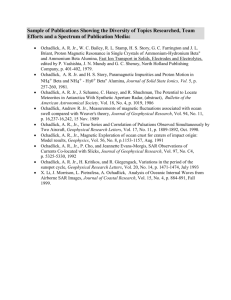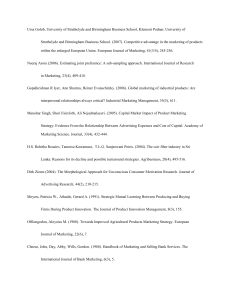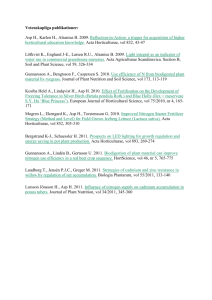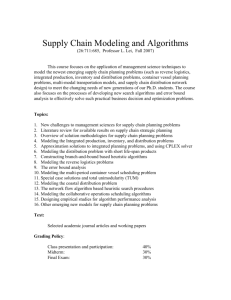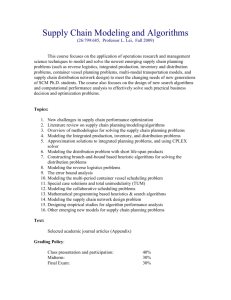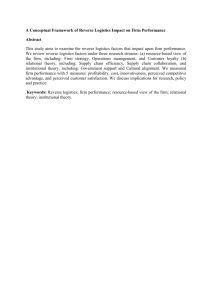Supply Chain Modeling and Algorithms
advertisement
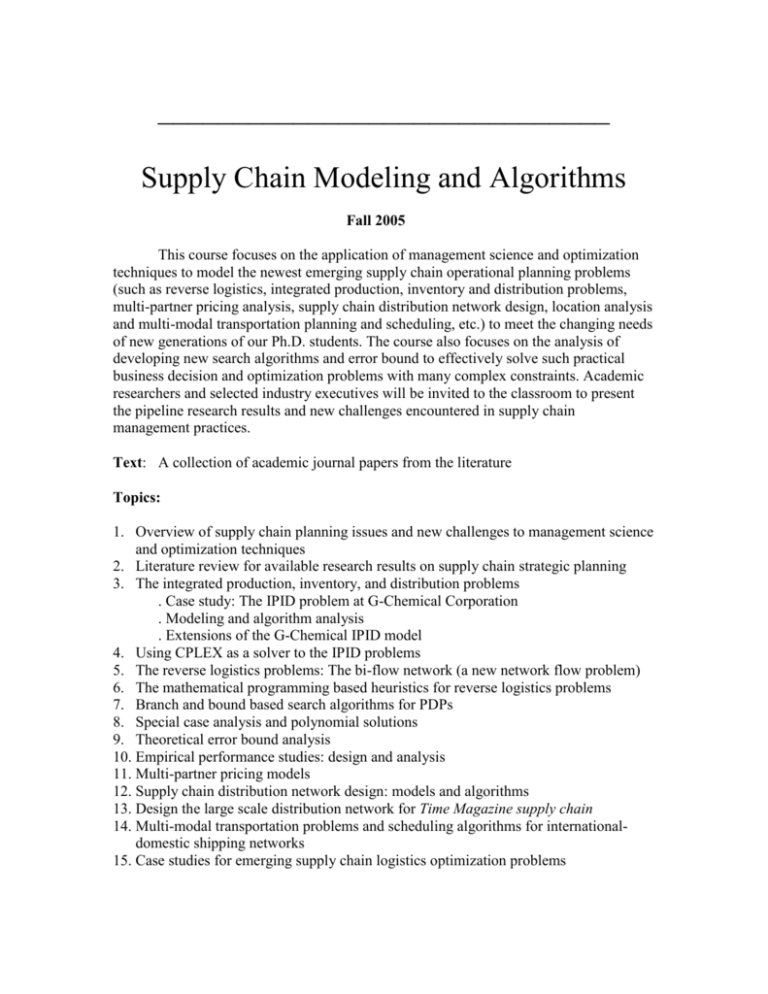
______________________________ Supply Chain Modeling and Algorithms Fall 2005 This course focuses on the application of management science and optimization techniques to model the newest emerging supply chain operational planning problems (such as reverse logistics, integrated production, inventory and distribution problems, multi-partner pricing analysis, supply chain distribution network design, location analysis and multi-modal transportation planning and scheduling, etc.) to meet the changing needs of new generations of our Ph.D. students. The course also focuses on the analysis of developing new search algorithms and error bound to effectively solve such practical business decision and optimization problems with many complex constraints. Academic researchers and selected industry executives will be invited to the classroom to present the pipeline research results and new challenges encountered in supply chain management practices. Text: A collection of academic journal papers from the literature Topics: 1. Overview of supply chain planning issues and new challenges to management science and optimization techniques 2. Literature review for available research results on supply chain strategic planning 3. The integrated production, inventory, and distribution problems . Case study: The IPID problem at G-Chemical Corporation . Modeling and algorithm analysis . Extensions of the G-Chemical IPID model 4. Using CPLEX as a solver to the IPID problems 5. The reverse logistics problems: The bi-flow network (a new network flow problem) 6. The mathematical programming based heuristics for reverse logistics problems 7. Branch and bound based search algorithms for PDPs 8. Special case analysis and polynomial solutions 9. Theoretical error bound analysis 10. Empirical performance studies: design and analysis 11. Multi-partner pricing models 12. Supply chain distribution network design: models and algorithms 13. Design the large scale distribution network for Time Magazine supply chain 14. Multi-modal transportation problems and scheduling algorithms for internationaldomestic shipping networks 15. Case studies for emerging supply chain logistics optimization problems Supply Chain Modeling and Algorithms Rutgers Business School, Fall 2005 Suggested Readings(Part I*): Ball, M. and M. Magazine. The Design and Analysis of Heuristics. Networks, Vol.11, pp 215-219, 1981. Chandra, P., and M. L. Fisher. Coordination of production and distribution planning. European Journal of Operational Research, Vol. 72, No. 3, pp 503-517. 1994. Chen, Z. L. Integrated Production and Distribution Operations: Taxonomy, Models, and Review. Supply Chain Analysis in the E-Business Era (Edited by D. Simchi-Levi, D. Wu, and Z.-J. Shen), Kluwer Academic Publishers, 2004. Chen, Z. L., L. Lei, and H. Zhong. On the container vessel scheduling problem with reverse flows (Under the second review) Operations Research Letters, 2005. Chien, T. W., A. Balakrishnan & R. T. Wong. An Integrated Inventory Allocation and Vehicle Routing Problem. Transportation Science, Vol. 23, No. 2, May 1989. Desrochers, M. and F. Soumis. A Generalized Permanent Labeling Algorithm for the Shortest Path Problem with Time Windows. INFOR, Vol. 26, No. 3, pp.191-212, 1988. Dowlatshahi, S. Developing a Theory of Reverse Logistics. Interfaces, Vol. 30, No. 3, pp 143-155, 2000. Dror, M and M. Ball. Inventory/Routing: Reduction from an Annual to a Short-Period Problem. Naval Research Logistics, Vol. 34, pp. 891-905, 1987. Fisher, M. The Lagrangian Relaxation Method for Solving Integer Programming Problems. Management Science, Vol. 27, No. 1, pp. 1-17, 1981. Geismar, N., G. Larporti, L. Lei and C. Sriskandarajah. The Integrated Production and Transportation Scheduling Problem with Expiring Product and Non-Instantaneous Transportation Time. (Under the second review) Journal on Computing, 2005. Guide, V. D. R., V. Jayaraman, R. Srivastava and W. C. Benton. Supply Chain Management for Recoverable Manufacturing Systems. Interfaces, Vol. 30, No. 3, pp 125-142, 2000. Jayaraman V. and A. Ross. A Simulated Annealing Methodology to Distribution Network Design and Management. European Journal of Operational Research, Vol. 144, pp 629-645, 2003. Jayaraman V., R. Ratterson, and E. Rolland. The design of reverse distribution networks: Models and solution procedures. European Journal of Operational Research, Vol. 150, pp. 128-149, 2003. Lei, L., A. Ruszczynski, S. Liu, and S. Park. Optimizing the demand-supply planning for The General Chemical Group (Under second review) IIE Transactions, 2005 Lei, L. H. Zhong, and W. Chaovalitwongse. On the bi-directional flow production and distribution problems (Under the second review) Journal on Computing, 2005. Lei, L. and Q. Wang. On the profitability of a three-partner channel. Journal of Operational Research Society (To appear), 2005. Lenstra, J. K. and A. Rinnooy Kan. Compexity of Vehicle Routing and Scheduling Problems. Networks, Vol.11, pp 221-227, 1981. Renaud, J & F. F. Boctor. A Sweep-based Algorithm for the Fleet Size and Mix Vehicle Routing Problem. European Journal of Operational Research, Vol. 140, pp 618-628, 2002. (* Part II readings will be assigned during the semester)



